Hong Kong Park
The Hong Kong Park is a public park next to Cotton Tree Drive in Central, Hong Kong. Built at a cost of HK$398 million and opened in May 1991, it covers an area of 80,000 m2 and is an example of modern design and facilities blending with natural landscape.
| Hong Kong Park | |
|---|---|
| 香港公園 | |
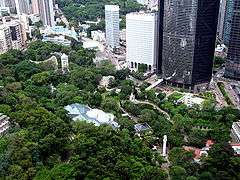 Aerial view | |
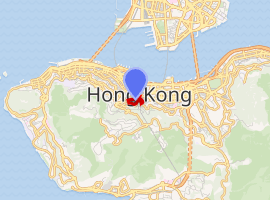
| |
| Location | Central, Hong Kong |
| Area | 8 hectares |
| Opened | May 1991 |
| Operated by | Leisure and Cultural Services Department |
| Open | Year round |
| Public transit access | Tram stop (25 m) Peak Tram terminus (30 m) Admiralty Station (200 m) |
| Hong Kong Park | |||||||||||||
|---|---|---|---|---|---|---|---|---|---|---|---|---|---|
| Traditional Chinese | 香港公園 | ||||||||||||
| Simplified Chinese | 香港公园 | ||||||||||||
| |||||||||||||
History
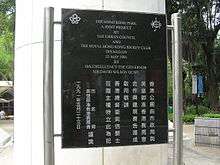
Part of the site was known as Cantonment Hill in early colonial days in 1841. At the upper part of the former location of the Victoria Barracks, built between 1867 and 1910, the barracks were handed to the government in 1979. Glenealy Junior School occupied part of this site up until 1988. After the school vacated the site, the area was turned into the present park. Hong Kong Park was officially opened on 23 May 1991 by Sir David Wilson, the Governor of Hong Kong at that time. It covers an area of 8 hectares and is an outstanding example of modern design and facilities blending with the natural landscape.
The construction of the park was a joint project by the Urban Council (dissolved in 1999) and the Royal Hong Kong Jockey Club (renamed the Hong Kong Jockey Club in 1996).
Historic buildings
- Flagstaff House (1846), since 1984 housing the Flagstaff House Museum of Teaware
A few historic buildings of former Victoria Barracks were also conserved in the park, including:
- Cassels Block (early 20th century), former barracks for married British officers. Now housing the Hong Kong Visual Arts Centre since 1992
- Rawlinson House (early 20th century), former house of the British Deputy General, converted in the 1980s into Cotton Tree Drive Marriage Registry and the office of the park.
- Wavell House (early 20th century), former quarters for married British officers, converted in 1991 into the aviary support centre (Education Centre).
These historic buildings are graded as Grade II Historic Buildings.[1]
The park can be easily reached by walking through the Pacific Place and its nearby escalator.
Facilities

Hong Kong Park captures the natural landscape in the busy and crowded business centre. Its main feature is Edward Youde Aviary which is Hong Kong's largest aviary while the Vantage Point is another great place to see the "bird exhibition". There is also a greenhouse (Forsgate Conservatory) which holds "plant exhibition" such as "Orchid Exhibition" temporarily. There are also many modern gardens, including Garden Plaza and Tai Chi Garden. To suit the sport-lovers, a sport centre and a squash centre were also built in Hong Kong Park.
Awards
Gallery
 Hong Kong Park is surrounded by skyscrapers in the highly urbanised central business district
Hong Kong Park is surrounded by skyscrapers in the highly urbanised central business district Hong Kong Visual Arts Centre in Hong Kong Park
Hong Kong Visual Arts Centre in Hong Kong Park- The greenhouse in Hong Kong Park
 Inside an aviary at the central Hong Kong Park
Inside an aviary at the central Hong Kong Park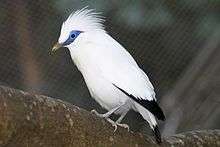 Bali starling in aviary at Hong Kong Park
Bali starling in aviary at Hong Kong Park Artificial Lake in Hong Kong Park
Artificial Lake in Hong Kong Park- Turtles in Hong Kong Park
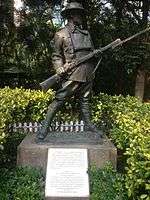 Statue of an anonymous World War I soldier from statuary collection of Eu Tong Sen.[5] Also visible is the Battle of Hong Kong memorial plaque dedicated to all the defenders of Hong Kong in December 1941 through John Robert Osborn.
Statue of an anonymous World War I soldier from statuary collection of Eu Tong Sen.[5] Also visible is the Battle of Hong Kong memorial plaque dedicated to all the defenders of Hong Kong in December 1941 through John Robert Osborn.- Memorial plaque dedicated to all the defenders of Hong Kong in December 1941 through John Robert Osborn and to commemorate the British Garrison at Hong Kong.
See also
- List of buildings and structures in Hong Kong
- List of urban public parks and gardens of Hong Kong
References
- List of Graded Historic buildings in Hong Kong(As at 6 Jan 2007) Archived 9 July 2011 at the Wayback Machine
- Hong Kong Park wins US architectural award, Hong Kong Government
- Awards Archived 9 April 2007 at the Wayback Machine, Far East Consultant Engineering
- Top Ten Buildings of the 90s Archived 5 April 2007 at the Wayback Machine, Building Journal
- Wordie, Jason (2002). Streets : exploring Hong Kong Island. Hong Kong: Hong Kong University Press. p. 231. ISBN 9789622095632.
External links
| Wikimedia Commons has media related to Hong Kong Park. |